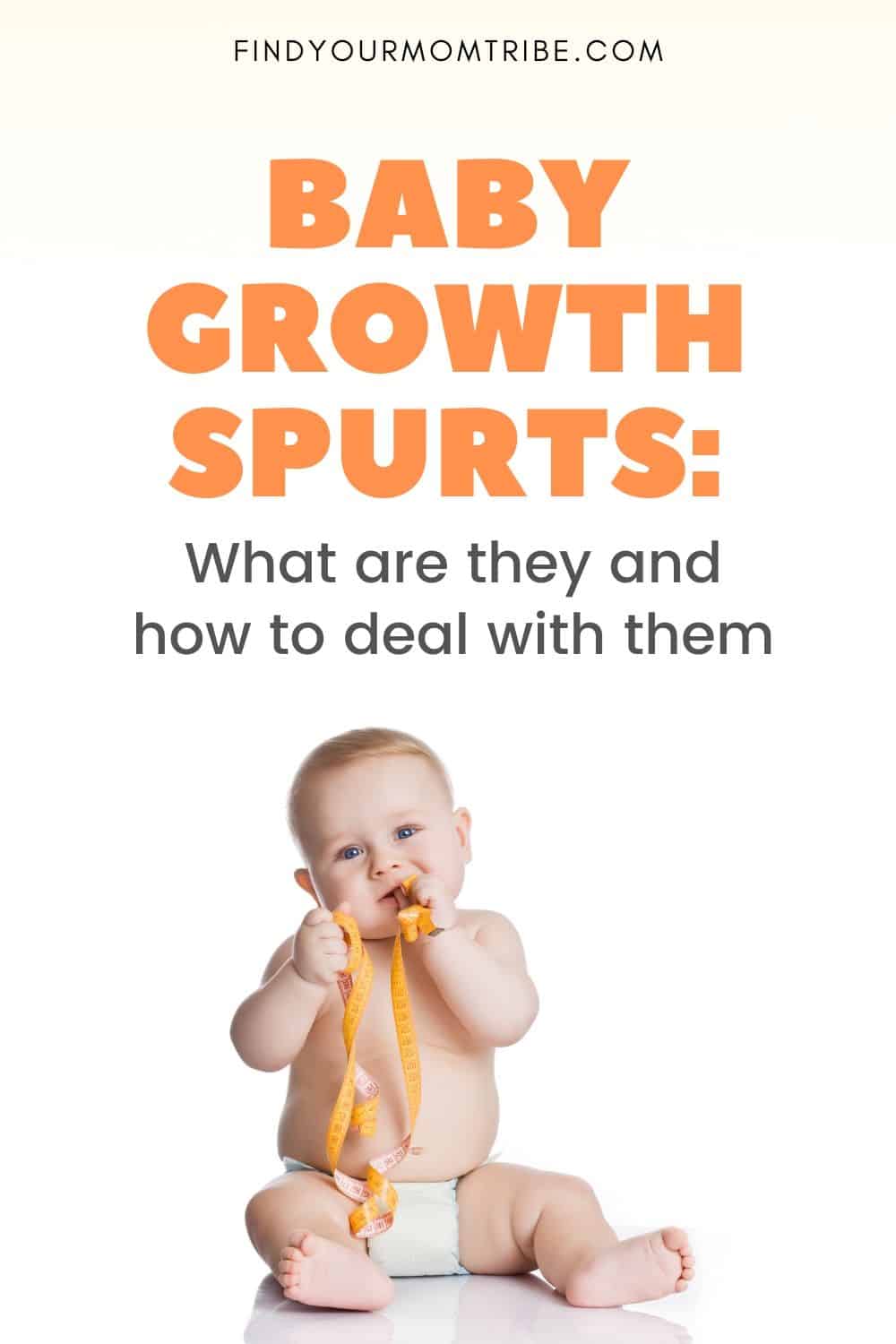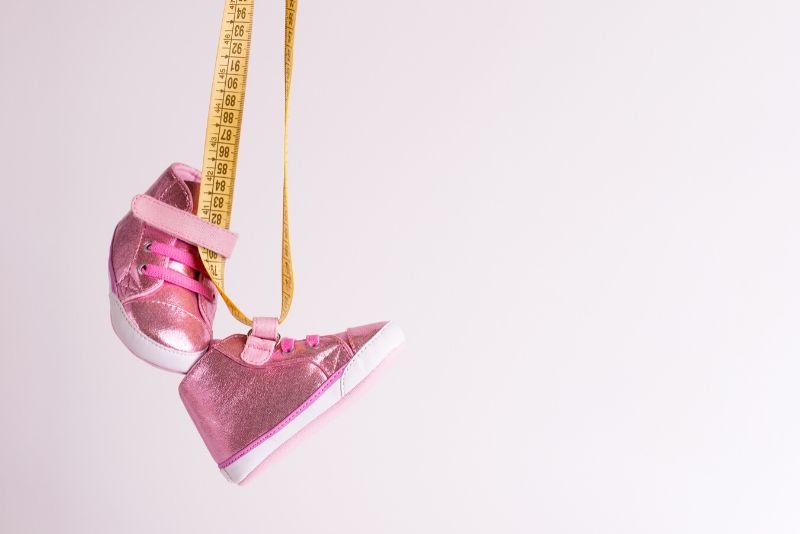Baby growth spurts are a normal stage of infant growth. They typically occur during your baby’s first year.
Studies conducted by experts show that growth spurts will typically occur at certain points during your baby’s development.
The most common times for growth spurts to occur are at:
- the first few days after coming home from the hospital
- around 7-10 days after birth
- around 2-3 weeks old
- 4-6 weeks old
- 3 months old
- 4 months old
- 6 months old, and
- 9 months old.
During these periods, growth hormones are released, and you will notice typical signs of developmental milestones in your baby.
Baby growth spurts do not completely end at the first year of your baby’s development.
Spurts will be noticeable every few months of your child’s toddler years.
Thereafter, your child will periodically go through spurts throughout the teenage years.

New mothers are often caught unawares by the changes, such as teething and fussiness, that occur during the baby’s development.
Fortunately, educating oneself is key to dealing with the changes that will occur in your little one.
Keep reading in order to learn a thing or two about what is happening with your baby’s growth in these first few months, and how to deal with it like a pro.
What exactly is happening during my baby’s growth spurt?
As we have established, a growth spurt is a normal part of the first year of your baby’s development.
However, children are different, and not all babies will show signs of infant growth at the same time during the first year.
Do not panic if this occurs. Your due date also plays a role in determining when your child has growth spurts.
Children born preterm tend to develop at a slower rate than children who are kept up to term.
However, if you feel your baby isn’t developing at an acceptable rate, you can consult a pediatrician to determine the cause.
Here are several signs that can hint at what is happening during your baby’s spurts.
Remember that every child is different. What your friend’s baby went through, may not happen with yours, and vice versa.
That said, look out for the following signs as they are great pointers.
1. Increase in the rate of feeding
The most noticeable sign of a growth spurt in your little one will often be an increase in his rate of feeding.
It is normal for your baby to want to eat more.
This is because his body will be using up most of the nutrients in growing his vital organs and maintaining important body functions.
If you have chosen to feed your little one breast milk, you will notice that he’ll tend to latch on for longer than usual.
If your baby is formula-fed, he may demand another bottle, or cry after a feeding.

2. Gaining a few pounds
Another obvious sign of your baby’s development is that he will begin to show some weight gain.
Your baby will put on a few pounds, which will be obvious when you try to pick him up. He will also grow a few centimeters, and his head circumference will increase.
While this occurs, you don’t have to weigh your baby regularly yourself.
Health professionals, such as a pediatrician or family doctor, will monitor your baby’s weight and progression throughout their early years.
In addition to that, you can track your baby’s weight and progress at home with a baby scale.

Growth charts based on the World Health Organization (WHO) Child Growth Standards are also used to assess your baby’s development in her early years.
3. Hitting developmental milestones
Another sign of a growth spurt in your baby is that he’ll begin to hit developmental milestones. He will begin to show signs of trying to communicate with you.
He’ll start to roll over, then crawl and drag himself along the floor. He may also babble a lot.
This is the stage when he may begin to say ”mama” or ”dada.”
As he progresses, he will eventually start to pull himself into the standing position and may even take a few steps.
RELATED: The 10 Baby Leaps: The Wonder Weeks Of Child Development

4. Change in sleep patterns
The most bothersome sign of a growth spurt in your baby is a change in sleep patterns. During this time, he will often sleep less.
This will cause fussiness and your baby may behave out of character. He may wake up more frequently at night, and take shorter naps.

On the other hand, you may be lucky and your baby may sleep more than usual.
If this is the case, then you should allow him to go on with her extended napping hours.
5. Changes in behavior
Teething will often occur in the first few months and will likely cause crankiness in your baby.
RELATED: Best Teethers: 13 Best Buys For Your Baby
Certain changes in your baby’s behavior will be evident during the spurt. He may demand way more attention than he normally would, and cry more often.
Studies have proposed that these changes may be as a result of all the energy your little one will expend in feeding and growing.
This will make him tired and could overwhelm him.

Is There Any Difference Between A Growth Spurt and A Feeding Spurt?
Both a growth and a feeding spurt will cause your baby to need more food, but they are not the same thing.
A feeding spurt occurs when your baby is hungrier than he usually is.
But although he may be consuming lots of nourishment, this doesn’t necessarily translate into rapid growth in the next couple of days.
A growth spurt however, will present with increased consumption and rapid growth in the following days.
A feeding spurt should not be confused with a growth spurt.
This will help prevent overfeeding and will let you know when and how to modify your baby’s routine.

How Long Will A Growth Spurt In My Baby Last For?
For the first few months of your baby’s life, growth spurts will occur frequently.
This is why the most growth is recorded in your baby’s first year.
To give you an idea of just how rapidly your baby will grow in his first year, take it from Dr Michelle Lampl, an expert in human growth and development: “Babies go to sleep, and they wake up longer!”
Growth spurts can last for about one to two weeks, or could be as short as one day to a couple of days.
However, as your baby grows older, the frequency of her growth spurts will slow down and occur every few months, or even further apart.

Should I Be Worried About My Baby’s Growth Spurts?
Absolutely not.
There is nothing to be worried about when your child is going through growth spurts.
If anything, you should be excited that your baby is going through this major process of human growth.
Admittedly, the crankiness, fussiness, and other signs that come with your baby’s development may bother you, but you can be rest assured that you have a healthy child in your hands.
However, discomforts like fevers, headaches, extreme irritability, the flu, or digestive problems are not caused by growth spurts.
If your baby shows any one of these signs, you must get her checked at the pediatrician.
If your baby experiences delays in showing signs of a growth spurt, please consult a general practitioner or pediatrician for sound medical advice.

How Do I Differentiate Between Fussiness From A Normal Growth Spurt And When Something Is Wrong?
As the spurts occur frequently, you will begin to notice a pattern.
Normal spurts will often occur at the same time of day, with the same intensity in response to certain stimuli.
You can even set your clock by its frequency!
However, fussiness caused by a problem will often occur sporadically.
There is no noticeable pattern, and your baby will not respond to usual comforting responses.
Take your baby to see a doctor if her fussiness starts to bother you.

What Do I Do When My Child Shows Signs Of A Growth Spurt?
When a growth spurt occurs, you must remember that your baby is the one who personally feels the pain caused by teething or lack of sleep.
She will project that pain on you by crying more frequently or being fussy because she sees you as a safe place.
To make things easier for the both of you, it is advisable to work at making a spurt easier to manage.
I will list a couple of tips that have been shown to help manage your baby’s spurt.
These tips are not set in stone, so you can improvise and discard those that don’t work for you.

1. Get help from family and friends
As a new mother, it’s important to get all the help you can. At this point, there is a tendency to become overwhelmed with your baby’s needs.
Make sure that your partner is actively involved in looking after the baby, especially at this time.
It also helps to speak with friends who have had babies and know exactly what you are going through.
Also, this is where letting your mother or mother-in-law take the reins comes in handy.
Some cultures have a tradition where one or both mothers spend time with you after childbirth.

Do not feel like a bad mother for letting your friends or family help with carrying the baby, shopping, or cleaning up the house.
2. Nourish your body
For you to take care of your baby, you must have enough energy. Take time out to nourish your body with healthy and balanced meals.
Be sure to also drink plenty of water.
All that breastfeeding you’ll be doing drains your body of fluids.
To maintain a healthy supply of breast milk, you need to keep yourself well-hydrated.
Proper nutrition is also very important for when you are breastfeeding.
RELATED:
- What Not To Eat When Breastfeeding: Specific Foods To Avoid
- Lactogenic Food: Top 20 Ingredients For A Better Milk Supply
Your body needs all the energy it can get to help you produce enough milk.
Nourishing meals will also up your energy, and enable you to look after the baby properly.

3. Be attentive to your baby’s appetite
As a result of the spurts, your child’s appetite is likely to increase or decrease.
You have to pay a lot of attention to her to know when she’s hungry. This will then help you practice on-demand feeding.
Allowing your baby to feed as often as possible will also help with your milk production.
This will only take a while, as her appetite will return to normal once the spurt is over.

4. Take walks outside with your baby
Babies tend to be fussy when cramped up indoors, and this fussiness will be aggravated with the spurts.
Take the stroller and go for walks with the baby. In addition to your baby being able to enjoy the new sights and sounds, you’ll also be getting some much needed exercise.
If your baby is happy, you are too.
It’s a win-win.

5. Be flexible with your routine
Before the spurts began, you and your baby may have established a routine for feeding, bedtime, and other things.
However, your baby’s routine will most likely be disrupted by her growth spurts.
She may sleep for lesser or longer times, blatantly refuse to latch onto your nipple or bottle, or demand more food than usual.
RELATED: When Your Baby Refuses The Bottle: Here’s How To Deal With It
You have to keep an open mind and let your baby do what seems convenient for her at the time.
Once the spurt has run its course, you can get back on track with your routine.

6. Allow an extra bottle
If your child is formula-fed, it is fine to allow an extra bottle if she wants one.
Remember, your baby is growing and will need all the nutrients she can get.

7. Get some much needed self-care
The period of baby growth spurts is often very challenging for both mom and baby.
Family and friends offering to help out around the house may not be enough to let go of pent-up stress and crankiness in mama and her little one.
You have to take out time to release the stress – for the sake of you both.
Self-care rituals are usually very effective in alleviating stress. If you have your hands full with the baby and can afford it, you can book a home massage.
Your partner can take over childcare duties while you go out to the spa.
Having a warm cup of soothing chamomile or matcha tea will also work wonders for your nerves.
Journaling, soaking in the bath, listening to podcasts, and going to see a movie, are also great ways to take care of yourself.
And as for the baby, try giving him a massage after bath time.
Babies love the feel of their mothers hands, and a massage would be a treat for them.

Putting a few drops of lavender or citrus essential oils in your baby’s bathwater is also a great way to relax him.
8. Use baby monitors
- FULL VIEWING CONTROL - The DXR-8 is a baby monitor with camera features such as pan/tilt/zoom and interchangeable lens. Fit the zoom lens to see closer, or zoom out with the wide angle lens. Expandable up to 4 cameras
- ROBUST AND MATURE HARDWARE - the DXR-8 is fine tuned and refined over years of iteration from feedback of real users. Trusted by over a million parents, our award winning monitor is backed by vigorous testing and quality control.
- PRIVACY GUARANTEED - Video and audio is transmitted via a secure 2.4GHz channel with FHSS technology. This ensures no data is shared through the internet.
Prices pulled from the Amazon Product Advertising API on:
Product prices and availability are accurate as of the date/time indicated and are subject to change. Any price and availability information displayed on [relevant Amazon Site(s), as applicable] at the time of purchase will apply to the purchase of this product.
If you have a nursery in your home, invest in a baby monitor. This will let you observe everything going on with your baby.
You can choose to get an audio monitor or an audio-visual one.
This will allow you to get your much-needed rest, as well as be on the alert when your baby needs you.
9. Get her toys
Toys can be a great distraction from the discomfort your baby may be feeling.
Children are very intrigued by sights and sounds and will often go exploring.
Toys like rattles, stuffed animals, pacifiers, teethers and even putting on cartoons are a great way to keep your baby happy.
You can join your baby in playing with these toys for some great parent-child bonding.

Won’t All This Attention Spoil My Baby?
Most people worry that constantly attending to their child will spoil him.
On the contrary, it is quite the opposite.
Studies have shown that babies that are held as often as they cry, will cry less.
With time, they begin to quiet down and the parents learn to read the baby’s cues faster.
Ignoring your child in hopes of them quieting down will only serve to further aggravate them.
A child that is perceived as fussy may simply just need more love and care from his parents. The bone of contention is how he chooses to express his need.
Remember that he sees you as a source of comfort and will most often express his desire for you by crying.
Once your child is given the tender love and care he needs at that point, he ceases to be fussy and everyone can get along just fine.

Don’t Be Too Hard On Yourself
I understand the stares on the bus that you will get from others.
Nobody else apart from family and close friends will know that your baby is going through a phase that’s hard for her.
People may tell you how much of an inadequate mother you are. There are some who’ll try to offer unsolicited advice.
Make a conscious effort to remain calm if it seems like your efforts have no immediate positive effects.
Your baby is attentive to your energy, and with time he will come to learn that he can trust you.
Offer support and be a shoulder to cry on to your new-mom friend.
Most importantly, your partner must actively be involved in this phase of your baby’s first year of life.
Work together and smash this period like pro parents.
Like this article? Please share or pin it for later. You can also stay in the loop and follow me on Facebook, Instagram or Pinterest.

We love honesty! Find Your Mom Tribe is an Amazon Associate and we earn from qualifying purchases through affiliate links at no extra cost to you. Please see our full Amazon Affiliate disclosure for more information.

